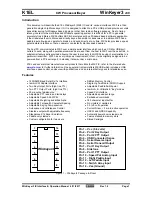
Virginia Controls, LLC
MH-3000 User Manual, 1_03C10-VC
Page 6
1.
Pre-Installation Instructions, Notes
1.1
General Notes
It is strongly recommend that you read this manual carefully before proceeding with the
installation.
Important information is highlighted by the headings WARNING, CAUTION, or NOTE.
These words are defined as follows:
WARNING - Warnings are used to indicate instructions which, if not
followed correctly, will probably result in personal injury or
substantial damage to equipment.
CAUTION - Cautions are used to indicate instructions or information which, if
not observed, may result in some damage to equipment if care is not taken.
NOTE - Notes are used to indicate instructions or information which are
especially helpful in understanding and operating the equipment, and which
will usually speed up the installation process.
1.2
Important Precautions And Notes
The following general rules and safety precautions must be observed for safe and reliable
operation of your system.
WARNING: If you need to change the EPROM program chip on the
CPU board, make sure you read the instructions and know exactly
how to install the new chip. Plugging the EPROM chip in upside-down
may damage the chip. Static electricity can damage the EPROM, so
avoid touching the pins on the chip, and ground yourself (by touching
the controller cabinet) before touching the chip or the controller. Do
not expose the EPROM program chip to bright light, and do not
remove the label over the EPROM program chip window.
WARNING: The elevator controller must be installed by experienced
field installation personnel. The field installation personnel must
know and follow all the rules and regulations pertaining to the safe
installation and running of elevators. Additional information for
specific devices (such as the valves, door operator, etc.) is the
responsibility of the manufacturers of those devices.
WARNING: This equipment is designed and built to comply with ANSI
A17.1, ASME A17.5 and CAN/CSA B44.1 and must be installed by a
qualified contractor. It is the responsibility of the contractor to make
sure that the final installation complies with all applicable local, state
and national codes, and is installed safely.









































